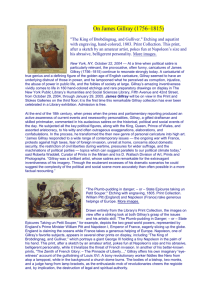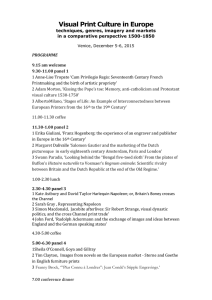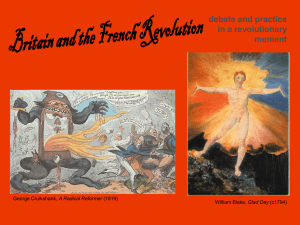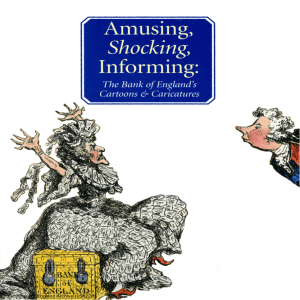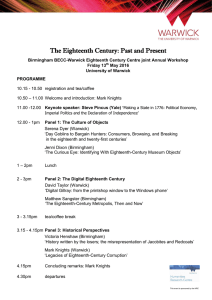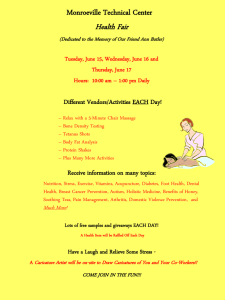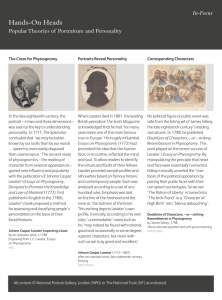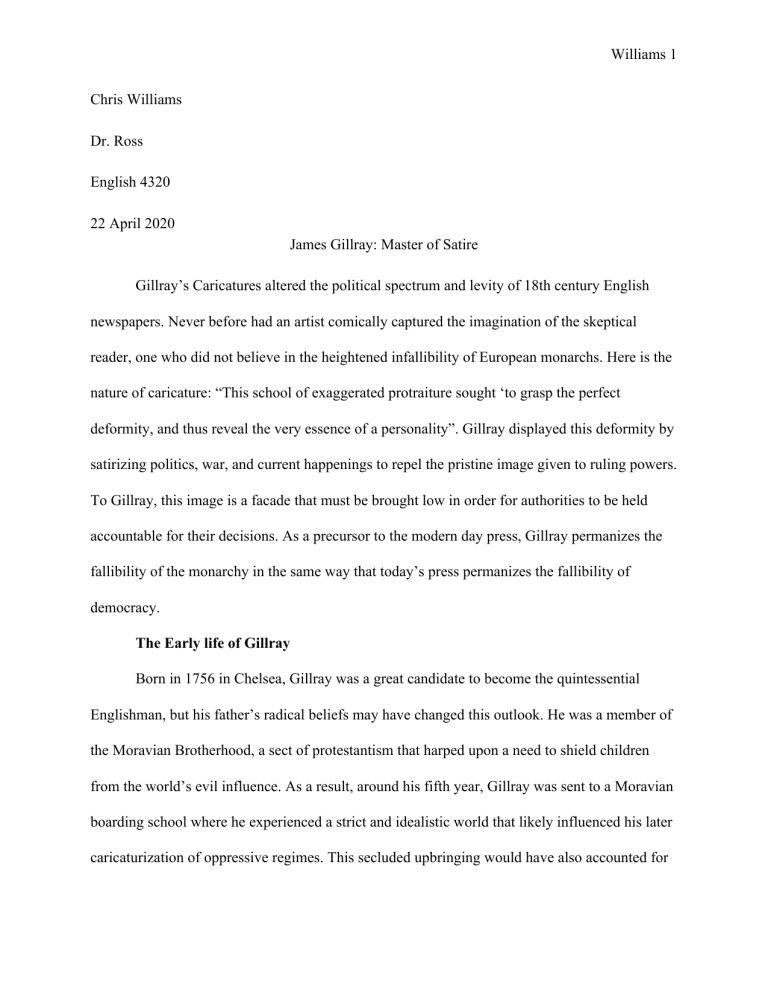
Williams 1 Chris Williams Dr. Ross English 4320 22 April 2020 James Gillray: Master of Satire Gillray’s Caricatures altered the political spectrum and levity of 18th century English newspapers. Never before had an artist comically captured the imagination of the skeptical reader, one who did not believe in the heightened infallibility of European monarchs. Here is the nature of caricature: “This school of exaggerated protraiture sought ‘to grasp the perfect deformity, and thus reveal the very essence of a personality”. Gillray displayed this deformity by satirizing politics, war, and current happenings to repel the pristine image given to ruling powers. To Gillray, this image is a facade that must be brought low in order for authorities to be held accountable for their decisions. As a precursor to the modern day press, Gillray permanizes the fallibility of the monarchy in the same way that today’s press permanizes the fallibility of democracy. The Early life of Gillray Born in 1756 in Chelsea, Gillray was a great candidate to become the quintessential Englishman, but his father’s radical beliefs may have changed this outlook. He was a member of the Moravian Brotherhood, a sect of protestantism that harped upon a need to shield children from the world’s evil influence. As a result, around his fifth year, Gillray was sent to a Moravian boarding school where he experienced a strict and idealistic world that likely influenced his later caricaturization of oppressive regimes. This secluded upbringing would have also accounted for Williams 2 Gillray’s frequent allusions to biblical ideologies in his works( Sherry). Gillray’s time at the Moravian brotherhood came to an end in October 1764 when the Moravians decided to dissolve their schools in the face of financial collapse. Forever altered by the religious influence of the brotherhood, around his teenage years, Gillray began working as an apprentice for Harry Ashby. Gillray reportedly compared this part of his life to that of a spider’s saying that he was “busied spinning lines”(Introduction to Gillray). This tedious work amounted to Gillray's displeasure so he deserted his apprenticeship and joined a group of strolling players with some of his pupils. He enjoyed the free roaming nature of this new expenditure, living in barns and enjoying “aimless theatrical pilgrimage”( Introduction to Gillray). However, eventually Gillray abandoned this lifestyle and returned to London, likely around the age of 19. Two unattributed satirical works produced during this time were likely Gillray’s; they bear the image of his early repertoire. At age 22 Gillray learned how to engrave letters and was granted admittance into the Royal academy(James Gillray). His first caricature, entitled “Paddy on Horseback” was published in 1779. This caricature features a man saddled backwards on a bull. Tied around him is a satchel that features a list of affluent women, the gibe here being that Irish men came to London to marry into wealth. This caricature was the first of a career that featured nearly caricatures, but most importantly it was part of a systematic rise of a new form of political satire. Gillray’s plates started to come in slowly around his early twenties, but Gillray did not give his full effort to caricature until he turned 30. The Mezzpoint Engraver, William Humphrey published most of Gillray’s early work, most of it concerning the topics of brothel and privy(Introduction to Gillray). A huge improvement of Gillray’s work came in the year 1778 after he was welcomed into the Royal Academy. Working under Franceso Bartolozzi Williams 3 The Rise of a new Medium: The Caricature In 1735 the English parliament enacted a copyright act that protected engravings for 14 years. This made it possible for Gillray's predecessors such as Hogarth to receive adequate compensation for their work; “Hogarth’s Act converted a largely speculative into a major industry”(Introduction to Gillray). This new industry mainly used copperplate engravings, limiting the quantity of engravings that could reasonably be sold to the market; a small minority of Gillray’s work was engraved into wood and lithography, but the vast majority of Gillray’s work was copper engraved. With such a small number of engravings being sold by artists in the market, most engravers like Gillray had the editorial freedom to publish the content of their liking, a freedom that would be taken from later caricaturists who found themselves working under regulated systematic journalism. M. D. George acknowledges the rise of this free journalism here: The caricature (using the term in its loosest sense) had superseded the ballad of Fletcher of Saltoun's day, to some degree it anticipated the news-reel and the illustrated paper. Instead of appearing in the papers at regular intervals, it was a separate work of art, an etching, usually coloured, and immediately striking to the eye.In London and Paris the print-shop windows were popular picture-galleries, each pane filled with a print and attracting crowds of gazers. English caricatures were exported in great numbers, and were copied and adapted in other countries. (9) Gillray’s specific plates were considered classics the moment they were released. His audience would have been far more literate and wealthy than average so they would have been capable of paying for his extravagant engravings and they would have understood his intelligent Williams 4 humor. In 1806, one of Gillray’s patrons stated that the print shop that featured Gillray’s work “was the only one in which upper class people with taste and knowledge were to be found”. Gillray’s portraits made their way all across Europe and even found their way to America. Gillray owes much of his rise to coincidental improvements in artistic techniques and the changing opinion of the reading public which began to adopt a negative sentiment towards authority. Authors like “Swift, Pope, Fielding, Charles Churchill, Junius, and numerous others” had shifted the hearts of the public towards a more critical attitude for monarchs such as Napoleon and King George III. Gillray’s plates featured intaglio prints made by forcing damp sheets of paper into contact with ink-loaded ‘trenches’, etched or engraved into a polished copper surface (Introduction to Gillray). This practice had originated in the 15th century, “based on a manual incision of a V-shaped furrow” (Introduction to Gillray). Gillray’s skillful work on the copper blank canvas made itself known all over Europe and even in America. His work will always be known for its importance in ringing in the modern journalist. It is impressive that before the day and age of photo-journalism, voice recordings and press releases, Gillray is able to paint a craft so in touch with what was happening behind the private curtain scenes of government. Williams 5 Works Cited George, M. D. “PICTORIAL PROPAGANDA, 1793–1815: GILLRAY AND CANNING.” History, vol. 31, no. 113, 1946, pp. 9–25. JSTOR, www.jstor.org/stable/24402580. Accessed 3 Feb. 2020. Hart, Katherine W. James Gillray Prints By The Eighteenth Century Master of Caricature. Hood Museum of Art , 1994. James Gillray Drawings and Caricatures 1756-1815. Shenval Press, 1967. Pound, Richard John. "Serial Journalism and the Transformation of English Graphic Satire, 1830-36." Order No. 10014980 University of London, University College London (United Kingdom), 2002. Ann Arbor: ProQuest. Web. 3 Feb. 2020. COOPER, JOHN. “5. James Gillray and the French Revolution.” RSA Journal, vol. 137, no. 5398, 1989, pp. 646–651. JSTOR, www.jstor.org/stable/41375006. Accessed 11 Feb. 2020. The Editors of Encyclopaedia Britannica. “James Gillray.” Encyclopædia Britannica, Encyclopædia Britannica, Inc., 4 Dec. 2019, www.britannica.com/biography/James-Gillray.
